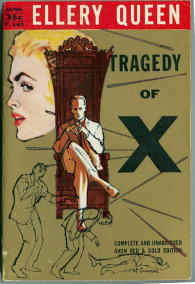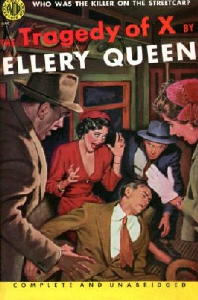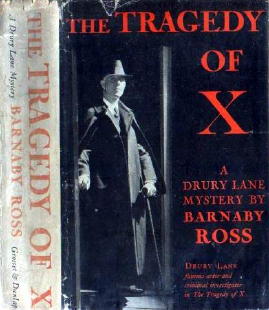Fri 25 May 2007
ELLERY QUEEN – Tragedy of X
Avon T-141; paperback reprint, no date stated, but generally accepted as 1956. Second Avon printing. Hardcover first edition as The Tragedy of X by BARNABY ROSS: The Viking Press, June 1932. Hardcover reprint: Grosset & Dunlap, mid-1930s. First hardcover edition as by ELLERY QUEEN: Stokes, 1940. (All editions that follow are all as by E.Q.) Hardcover reprints: Grosset & Dunlap, circa 1940 [or 1943]; University of California Extension, 1978 [Mystery Library, Volume 7; introduction & checklist by Francis M. Nevins, Jr.]; Bookthrift Co., 1986. Paperback reprints: Pocket 125, 1942; Avon 425, 1952; Avon S206, 1966; IPL, 1986.
Whew. And who knows, I may have missed an edition or two. In order to tell you more about the history and other insights about the book, I wish I had the Mystery Library edition, with the introduction by Mike Nevins. But I don’t, and I won’t try to fake it, but I will insert one short note I found on wikipedia.com: “For a while in the 1930s ‘Ellery Queen’ and ‘Barnaby Ross’ even staged a series of public debates in which one cousin impersonated Queen and the other impersonated Ross.”
What I’d be interested in knowing is how, when and who started to put two and two together and deduced the fact that Queen and Ross where one and the same. The four Barnaby Ross books came out in rapid succession during only a two-year period between 1932 and 1933, then there were no more. That the fourth one was titled Drury Lane’s Last Case made it as final and conclusive as possible there were only going to be four, even given the earlier resurrection of one Sherlock Holmes.

I believe I have read all four, but if I did, it was something like 50 years ago. When I came to read this one, now in my maturing years, I quickly discovered that it really didn’t matter if I really had read the book once before: I didn’t remember any of it, including (and especially) the ending, which tended (this time around) to knock my socks off. Whether it did or not before is a matter of only conjecture, but why else would I so vividly recall having read it, even without any accompanying details?
Drury Lane is the detective in all four mysteries, a retired (and deaf) Shakespearean actor with a penchant for helping the police in a purely amateur (but not amateurish) fashion, in particular and to whit, District Attorney Bruno and Inspector Thumm. On page 56 there is a reference to Lane’s giving them a hand on the “Cramer mess,” but since that case seems to have never been recorded, this would have been the reading audience’s first introduction to the man. (I picture John Carradine in the role, myself.)
Murder number one is that of a man poisoned to death on a trolley car. Means: a cork with needles dropped in the victim’s pocket. Circumstances: only one of the people on the trolley could have placed it there. More deaths follow, each one connected and each one as hopelessly complicated in commission as the first. Don’t expect anything like proper police procedure. The emphasis was on fooling the reader, in as extravagant a fashion as possible. For my money, the two men who were Queen succeed, and on all counts.

Well, let me quibble on that last statement perhaps a bit. That there are some awkward moments, designed not for realism, but caused by the authors’ reluctance to not reveal all too soon, as goes almost without saying. Drury Lane says more than once, for example, in true classic sleuthing style, that he knows who the killer is, but he can’t say who it is. Statements like this are always annoying, no matter which classic sleuth it is who says it. That it takes 36 pages for the solution to be revealed, step by step, will tell you something about what kind of book this is, as if you didn’t already know. In the explanation, though, Lane also reveals how he knew, and even more — and this is the clincher — why he couldn’t say who when he did.
This is also one of those kinds of mysteries which I do not believe are written any more, nor have they for a long time, in which the key to killer’s identity is not revealed until the last page.
Make that the last paragraph. The last sentence. And, keeping in mind the title: The. Very. Last. Letter.
X.

No, they don’t write books like this any more. Even given the quibbles I mentioned, wow, what a pleasure this was to read. (I did mention up above what happened to my socks, didn’t I?)
May 30th, 2007 at 7:50 pm
[…] The puzzle of the mystery is classically done as well, what with time tables and the shrewdest of plans concocts by the villain(s) involved. The last line has nothing to do with the mystery (as opposed to the Ellery Queen novel I covered not so long ago), but if you care anything at all about the characters, it will make absolutely certain that you will not miss where the next episodic installment of their amusing romance (but not to them) will take them next. — September 2006 […]
June 7th, 2007 at 10:41 pm
[…] Yes, yes, I know. Some of you are yawning already, and so was I for a while, but by page 108 the dialogue between the characters had become almost lyrical, the repartee flowing both easily and wittily, with Booth always firmly centered at the focal point. The method of the murder is clever enough, although highly unlikely, and with no perhaps about it. But one could say that of the Queen effort commented on a short while ago, couldn’t one? […]
February 21st, 2008 at 4:37 pm
[…] an Ellery Queen novel I liked more, read my review of The Tragedy of X here. […]